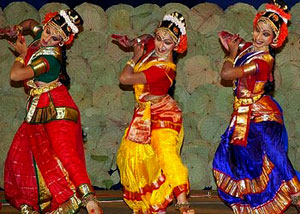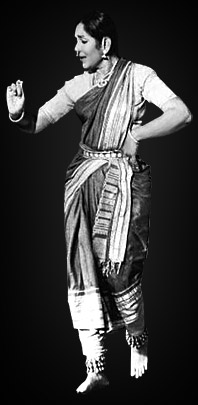 The name of the Bharatanatyam comes first while talking about the dance styles of Tamil Nadu. It is the classical dance style of the state. The name of this dance form brings into mind the images of a young, beautiful girl dressed in brilliant silks and ornamented with jewellery, dancing on a proscenium stage with the tune of a Carnatic music ensemble seated on one side.
The name of the Bharatanatyam comes first while talking about the dance styles of Tamil Nadu. It is the classical dance style of the state. The name of this dance form brings into mind the images of a young, beautiful girl dressed in brilliant silks and ornamented with jewellery, dancing on a proscenium stage with the tune of a Carnatic music ensemble seated on one side.
The Bharatanatyam dance style of Tamil Nadu is full of colour, spectacle, movement, rhythm, music and poetry. This energetic art form had its origin to the Natya Shastra, the world`s oldest treatise on theatre. But with the ages, the Bharatanatyam dance style has evolved and the dance style of Tamil Nadu became a distinctly native form.
The earliest reference of the Bharatnatyam dance form was found in Silappcidikaram, the Tamil epic of the 5th century A.D) in which Madhavi, one of the heroines was a dancing girl. At that time, dance turned as an exclusive profession of women of Tamil Nadu and the women dedicated to the temples were called devaradiyars or devadasis (servants of the Gods). Such women following the devadasi dance style were not allowed to marry and they used to dance in the temple as part of the rituals. It is known from the historical facts that there were about 400 devadasis in the service of the temple of Brihadisvara at Tanjavur of Tamil Nadu, which was built by Raja Raja Chola I in the 10th century A.D.
There also used to be rajadasis and alankara dasis, who were patronised by kings and chieftains. The dace style of the devadasis was known as `sadir` or `chinna melam`.
There were male `nattuvanars`, who trained the devadasis and conducted the recitals, but were they never performed themselves. There were rich cultures of various dance styles in the Kaveri delta and around Tanjavur of Tamil Nadu. People of the some of the villages of the state like Pandanallur, Vazhuvoor, Thiruvidaimarudur, Vaideeswarankoil and others dedicated their most of the time in practicing different dance styles for generations. The present dance style of Tamil Nadu developed in the 18th century by a significant family of four brothers, called the Tanjavur Quartet. These four brothers were called Chinniah, Ponniah, Vadivelu and Sivanandam. They were renowned musicians, composers and nattuvanars. They were the appointed in the court of king Serfoji II, who was a great patron of the arts.
 When the British came in rule, the temples were affected badly and the patrons and the devadasis fell on bad days. This dance form along with the performers and the patrons were disgraced. The worst situation arose to this dance style when the Tamil Nadu government banned the dance from the temples. Thus the devadasis lost their occupation and sustenance. Therefore, the nattuvanars shifted to the cities to look for new opportunities. This dance style would have become extinct but it got revived by the artists and art lovers in the 1940s. There were mainly four persons, who worked hard for the cause and Bala-saraswathi was one of them. She was one of the last of the devadasis and was a legend in her own time. E Krishna Iyer, a supporter for the cause of sadir, renamed this dance style as Bharatanatyam and gave it a new uprightness and persuaded the leading sabhas of Madras to feature the dance.
When the British came in rule, the temples were affected badly and the patrons and the devadasis fell on bad days. This dance form along with the performers and the patrons were disgraced. The worst situation arose to this dance style when the Tamil Nadu government banned the dance from the temples. Thus the devadasis lost their occupation and sustenance. Therefore, the nattuvanars shifted to the cities to look for new opportunities. This dance style would have become extinct but it got revived by the artists and art lovers in the 1940s. There were mainly four persons, who worked hard for the cause and Bala-saraswathi was one of them. She was one of the last of the devadasis and was a legend in her own time. E Krishna Iyer, a supporter for the cause of sadir, renamed this dance style as Bharatanatyam and gave it a new uprightness and persuaded the leading sabhas of Madras to feature the dance.
Rukmini Devi Arundale was another pioneer of this dance style of Tamil Nadu. She started Kalakshetra, the first institution to teach Bharatanatyam, as an academic discipline. Kamala was one more inspiration for this dance style. She was only ten years old and was genius in performing Bharatanatyam on films, which inspired every mother of Tamil Nadu to teach this dance style to her daughter.
Now, this dance style of Tamil Nadu has spread to other states of the country and even to other countries. Various dance schools have been set up in all over the world and people of other countries are also coming to India to learn the art in its home. But the form has maintained its purity and its repertoire were continuously enriched all the time with inputs of new compositions and concepts. Earlier, the Bharatanatyam dance style involved solo performance but now various dance dramas and thematic presentations are giving scope to group dancing. In the 20th century, the male dancers entered into this dance style for the first time.
The presiding deity of this dance style of Tamil Nadu is Nataraja, (king of dance). The icon of Nataraja is placed on one corner of the stage during every performance. The traditional sequence of the Bharatanatyam dance style involves a string of items, long and short, emphasizing one or more aspects of the dance such as nritta (pure dance), abhinaya (expressive dance) or a combination of both. Even a common person can enjoy the music and the spectacle of the dance to a great extent. The performer must have a deep knowledge of its idiom and intricacies for performing the dance perfectly.
The state of Tamil Nadu has also other art forms apart from Bharatanatyam. This includes the Bhagavata mela, and temple rituals like the Araiyar sevai, which use some aspects of Bharatanatyam. There are several folk dance styles like the karagam, poikkaal kndirai, oyil aattam, thappaattam, kummi, kolaattam etc., which are generally performed in groups and have a rural foundation.



















